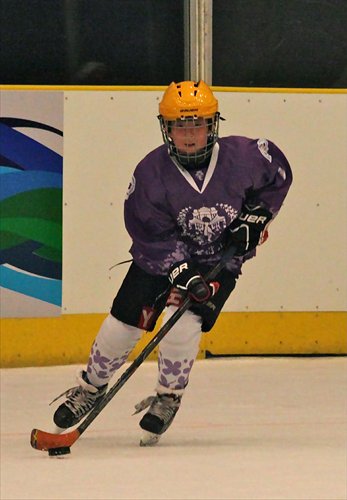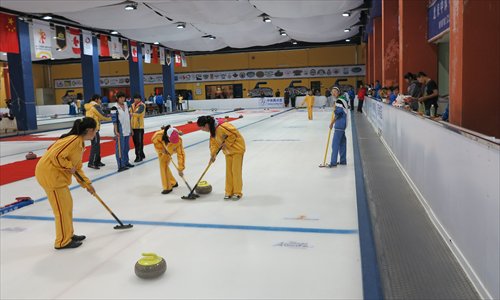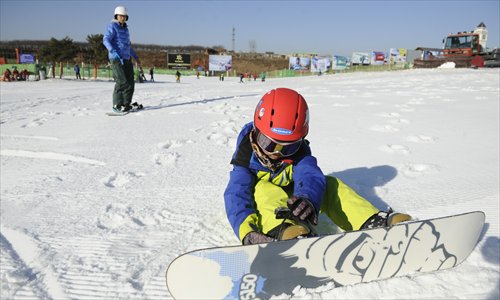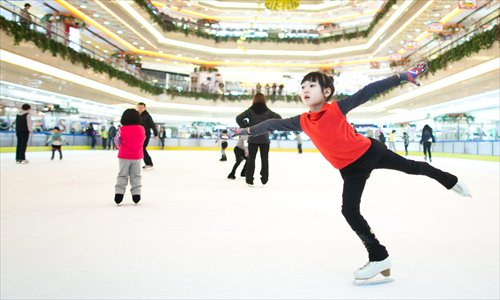Out of the cold
Winter sports are on the rise in Beijing in the wake of Olympics bid

He Shuyang, a 10-year-old ice hockey player from Tsinghua University Primary School, at a rink in Haidian district. Photo: Courtesy of He Ning
Every Saturday afternoon, amid the pulpit of tittering schoolgirls and sappy young couples at the Chaoyang Joy City ice skating rink, 10-year-old ice hockey player He Shuyang trains for four and half hours, practicing aggressive turns and running through drills to increase his speed.
Despite his young age, he is an old hand at the sport, having first picked up an ice hockey stick when he was four. Along with his younger brother, He Shuyang plays for two squads - the Tsinghua University Primary School team and the Ice Loong Ice Hockey Club - leaving little time for other recreations. But he wouldn't have it any other way.
"The sound of stick hitting the puck, the puff of ice that comes off the rink after you've hit it, it's so cool!" He enthuses. "My favorite part of ice hockey is checking for the ball and [body checking] other players."
He and his brother are part of the recent boom in the popularity of ice hockey in Beijing, following the capital's joint bid with Zhangjiakou in Hebei Province to host the 2022 Winter Olympic Games.
Pei Dongguang, director of the Olympic Education Research Center at the Capital University of Physical Education and Sports who was involved in drafting the application for Beijing's Winter Olympics bid, said the bid was an opportunity to encourage the growth of traditionally Western winter sports in China. "We pledged in the application that we will get more than 300 million people to become involved in various winter sports [before 2022]," said Pei.
As part of the Winter Olympics bid, Beijing's municipal government has implemented a number of initiatives to promote the development of winter sports in Beijing, including subsidizing coaching fees and the use of facilities at private winter sport clubs, according to a Xinhua News Agency report.

Two teenagers learn how to curl at I Sweep Curling Club in Huairou district. Photo: Courtesy of Cui Yuping

A boy with his snowboard at Nanshan Ski Resort in Miyun county. Photo: Li Hao/GT
Reality check
One of the fastest growing winter sports in the capital is ice hockey. There are currently around 1,800 players registered with the Beijing Ice Hockey Association in the capital, and 96 teams competed in last year's Beijing Youth Ice Hockey Championships, 20 more than in 2013, according to the association's deputy head and secretary, Liu Ge.
"The popularity of ice hockey among youth has grown rapidly these past two years," said Liu. "More primary schools are supporting ice hockey teams to attend competitions, more financial and emotional support is being given by parents, and there are more new rinks in Beijing."
Although Liu's comments indicate reasons for optimism, the continued growth of ice hockey in China faces a number of challenges.
At the moment, the sport remains prohibitively expensive to a large number of people. Kang Ping, He's mother, said that the family had spent around 210,000 yuan ($33,726) on equipment, coaching, use of facilities, and competition entry fees this year to support the two boys to play ice hockey.
Another obstacle, betraying the fact that ice hockey remains at a fledgling stage of development in China, is that although there are roughly 20 Beijing primary school teams, there is at present only one middle school ice hockey team and no high school ice hockey teams in Beijing.
Kang however, was confident that both of these stumbling blocks could be overcome, especially in the wake of Beijing's Winter Olympics bid.
"With Beijing and Zhangjiakou's joint bid for the 2022 Winter Olympic Games, the government is paying much more attention to the development of winter sports," said Kang, 42, who noted that Beijing No.4 Middle School was the latest to have an ice hockey team. "I believe that in the next few years, more middle schools will have ice hockey teams."
Liu said that the Beijing Ice Hockey Association was taking an active role in encouraging greater participation of ice hockey in middle schools by visiting and giving demonstrations where students are given the opportunity to experience the sport firsthand. He said that they have also launched an online platform where people can buy secondhand ice hockey equipment to try to reduce the burden on parents and players.
"One of the biggest obstacles facing the continued development of ice hockey is the cost," said Liu, who explained that part of the reason it was so expensive was because equipment needed to be imported from overseas. "The local government should give more subsidies."

A girl figure skating at a rink in Dongcheng district. Photo: Li Hao/GT
Curling
One sport where the effect of the government's initiative to promote winter sports has already been felt is curling - a sport that originated in medieval Scotland, in which players slide granite stones across the ice towards a target. The course of the stone can be altered by teammates with brooms, who "sweep" the ice, and the team with the most stones nearest the target after all the stones have been thrown scores a point.
"My daughter can now play for free," said Cui Yuping, the mother of a 16-year-old curler Li Yanying. "Three years ago, I had to pay about 2,000 yuan for 30 classes [at I Sweep Curling Club in Beijing's Huairou district], but now it's completely subsidized by the government."
Li has been curling ever since she was 12, and goes to the Huairou-based club once every week, for two hours. She also participates in competitions held at the club.
"When I first pushed the curling stone on the ice I found it quite fun. I never knew about this kind of sport before I tried it," said Li. "Maybe some people find the idea of pushing a stone and then following it and sweeping the ice like crazy a little bit silly, but for me, I found it interesting. It's helped me to become better at solving problems and working with others."
Wei Deguang, the owner of I Sweep Curling Club, said that there are more than 50,000 curlers in Beijing. However, the challenge facing the sport's development was that people under the age of 18 accounted for only around 1 percent of participants, according to Wei.
To encourage the sport's growth among China's youth, the Beijing municipal government are subsidizing the cost of coaching and use of facilities where curling can be played, said Wei. "The number of young players has increased, due to [the bid for] the 2022 Winter Olympic Games," said Wei. "This winter, around 100 children registered [at the club], which is a lot more than the number that registered for our summer curling camp."
Wei said that curling was a game for all ages. "There are no limits or restrictions on who can play. Our youngest curler is only 4 years old, so the only requirement is enthusiasm!"
Figure skating
One of the more firmly-established sports in China that is receiving renewed attention in the wake of Beijing's Winter Olympics bid is figure skating. Included in the first Winter Olympics in 1908, China has had a number of successes at the highest levels of international competition, most notably with Shen Xue and Zhao Hongbo taking home the pairs skating gold medal at the 2010 Vancouver Olympics. Now retired from competition, the two continue to work as coaches to groom the next generation of China's figure skaters.
Wang Xuehan, 16, is one of this new generation. She has been part of the Chinese national figure skating team since 2012.
"When I was under 10, I accidentally saw an ice skating rink in a shopping mall, said Wang. "My first time on ice, I stayed for longer than an hour. I didn't want to leave. Now, the sport is my dream," Wang said in an interview with Beijing Youth Daily in 2013.
Although, according to the report, there are "thousands" of children learning to figure skate each year in the capital, the sport remains out of reach to many due to cost. In the report, Guo Zixing, manager of the iCool Club which boasts an Olympic-sized figure-skating rink and a number of famous coaches, the cost for a child to learn how to figure skate is around 30,000 to 40,000 yuan per year.
"If a parent wants their child to succeed in making it into the national team, it could cost more than 1 million yuan per year," said Guo in the report.
Learning life lessons
Guo also noted in the report that more and more high-income families were encouraging their children to take up winter sports, such as figure skating and skiing, with the belief that it would better their chances for attending universities overseas when they were older, as well as helping them to integrate into life abroad.
Cui acknowledged that this played a part in her thinking.
"I heard that in some countries like Canada, universities prefer students who participate in sports," said Cui. "If my daughter applies for a university overseas in the future, the fact that she did curling can be one of her selling points."
He Shuyang's father however, said what was more important was the personal growth he had seen his two boys undergo since picking up ice hockey, and that playing the sport made them happy.
"He used to be introverted and shy," said He Ning, the father of the two boys. "But now he's become more outgoing and confident."
"I've made more friends," said He Shuyang. "And I've learnt how to work with others."